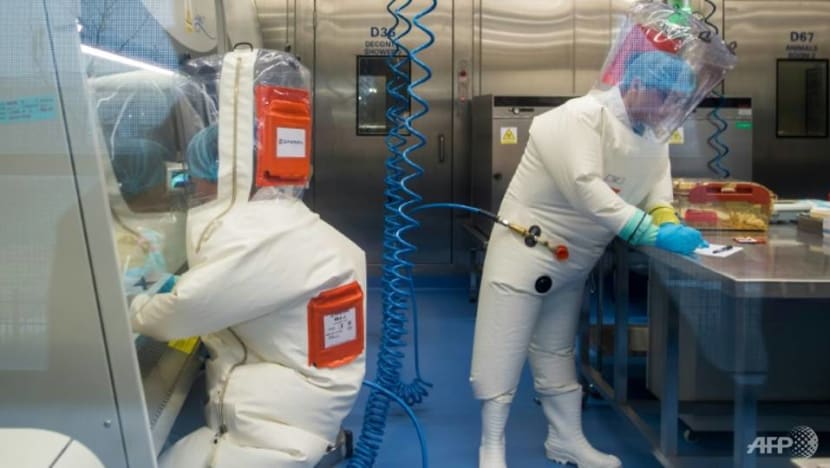Commentary: Whether COVID-19 came from a lab or animal is beside the point amid US-China diplomatic freeze
The new cold war between the US and China makes another pandemic more likely, says Edward Luce for the Financial Times.

The Wuhan lab is the largest virus bank in Asia and preserves more than 1,500 strains, according to its website. AFP/JOHANNES EISELE
WASHINGTON: Viruses thrive on ignorance. China’s refusal to co-operate with investigations into COVID-19’s origins is thus self-harming. Not only does it deepen fears that China will be late in alerting the world to the next novel virus outbreak; it fans conspiracy theories that coronavirus was a Chinese plot.
More than three years after COVID-19 erupted, the world has made little progress on preparing for the next pandemic, which is probably a question of time. The fact that the United States and China are ensnared in a cold war makes such transparency seem increasingly fanciful.
Cold wars stem from mistrust. Global health warning systems are built on trust.
Whether COVID-19 came accidentally from a lab in Wuhan or a seafood market is almost beside the point. Last week, the US Department of Energy joined the FBI in saying it thought the virus leaked from a Chinese lab. Neither have strong confidence in that explanation, while the CIA is undecided. Other US government bodies think COVID-19 is more likely to have come from an animal.
We may never get to the bottom of this. But discovering COVID-19’s origins is not the real concern. Whatever their line on this one, most scientists agree that the next pandemic could come either from the wild or a laboratory.
Humanity’s interest is to stop it from happening. The diplomatic freeze between the US and China is making that very difficult.
America’s growing tendency to demonise China - and the fact that China keeps supplying it with material - poses a threat to global health.
WHERE AMERICANS STAND ON COVID-19
No part of the US political spectrum has covered itself in glory. On the left, and in much of the media, there has been a tendency to rubbish any lab leak theory as conspiracy, or even racist.
This was partly in reaction to then president Donald Trump talking of “Chinese flu” and the “Wuhan virus”. The fact that Trump began the pandemic repeatedly congratulating Chinese President Xi Jinping on his handling of it makes this even more bizarre.
On the right, COVID-19 was an ideal weapon to expose the perfidies of communist China. The “China lied, Americans died” line quickly took hold and has stuck. Often the same figures claiming that Beijing covered up the origins of the deadly virus, or unleashed it as a bioweapon, insisted that COVID-19 was no worse than flu.
Culture warriors are rarely overburdened with logic. Rage against them blinded liberals to the possibility that the virus may have escaped from a lab. To underline: People with no scientific background are dealing in the kind of certainty that scientists are trained to avoid.
Where Americans stand on COVID-19 largely depends on their politics. The same is true for geopolitics. It is worth stressing that the US and China were not yet in a cold war when COVID-19 broke out. Few observers would dispute that they now are.
HARD TO PICTURE US-CHINA COOPERATION POST-COVID
Disease may thus be both an accelerant of a new cold war and a byproduct of it. China deserves a lot of the blame. Beijing’s wild policy swings on COVID-19 have contributed to America’s increasingly bipartisan Sinophobia. Two effects stand out.
First, China gives the impression it has something to hide. It has penalised anyone claiming that it has not been transparent.
Australia, which was the first country to call for an inquiry in 2020, paid the highest price, when Beijing imposed steep tariffs on a range of Australian exports. If Xi thought that killing the chicken would scare the monkey, his efforts backfired.
China’s reaction made Australia more hawkish and did nothing to deter the US. China did eventually agree to a World Health Organization inquiry but closed it down after scientists requested access to the Wuhan virology lab.
Second, Xi’s U-turns on COVID-19 have damaged China’s reputation. They have abetted those who argue that US foreign policy should respond to a regime’s internal character, rather than its national interests. Whatever America’s faults, it would be hard for a democracy to suppress inquiries into a pandemic, let alone jail its whistleblowers, as China did.
US President Joe Biden’s goal is both to cooperate and compete with China. Combining these contrary aims was always going to be a tightrope walk. It is now alarmingly hard to picture.
Beijing’s reluctance to play global citizen on pandemic warning systems - on top of climate change and other common threats - means we are hearing far less from Washington about cooperating with China and far more about confronting it.
If past is prologue, the next pandemic will probably come from China. This is simply a function of population density.
It is understandable that Beijing reacted defensively to any hint that it caused a disease that claimed close to 7 million lives and cost the world trillions of dollars. But it is self-defeating. Ensuring the scientific trail goes cold guarantees the focus will be on the nature of China’s political system.
The cost of COVID-19 can also be measured in damage to global psychology, including a form of diplomatic long-COVID. The world’s superpower and its rising great power are both now working from home and nourishing paranoia about each other. When we look back on COVID-19, that may be its biggest cost.















